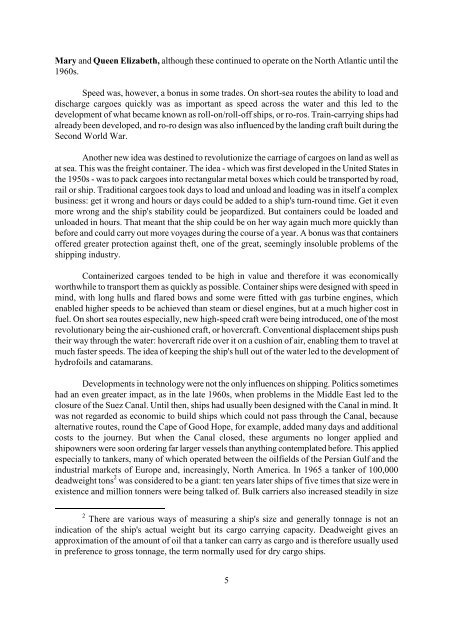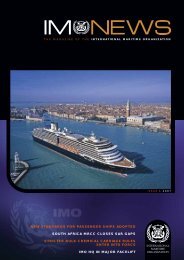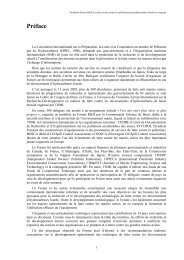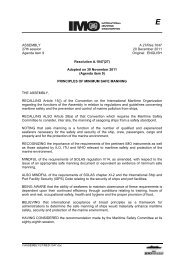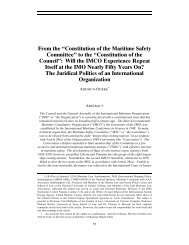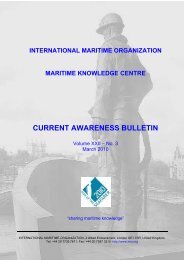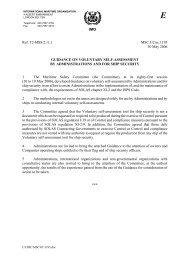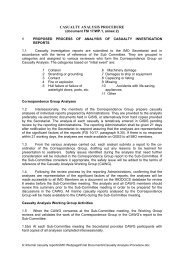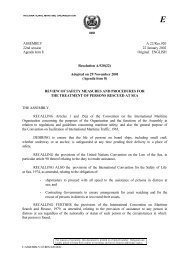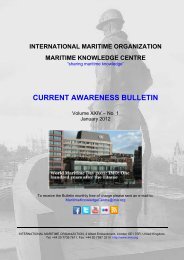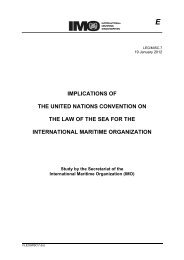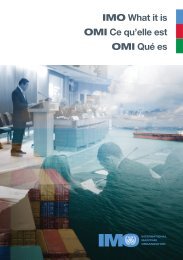wmd 1998 background document.pdf - IMO
wmd 1998 background document.pdf - IMO
wmd 1998 background document.pdf - IMO
Create successful ePaper yourself
Turn your PDF publications into a flip-book with our unique Google optimized e-Paper software.
Mary and Queen Elizabeth, although these continued to operate on the North Atlantic until the<br />
1960s.<br />
Speed was, however, a bonus in some trades. On short-sea routes the ability to load and<br />
discharge cargoes quickly was as important as speed across the water and this led to the<br />
development of what became known as roll-on/roll-off ships, or ro-ros. Train-carrying ships had<br />
already been developed, and ro-ro design was also influenced by the landing craft built during the<br />
Second World War.<br />
Another new idea was destined to revolutionize the carriage of cargoes on land as well as<br />
at sea. This was the freight container. The idea - which was first developed in the United States in<br />
the 1950s - was to pack cargoes into rectangular metal boxes which could be transported by road,<br />
rail or ship. Traditional cargoes took days to load and unload and loading was in itself a complex<br />
business: get it wrong and hours or days could be added to a ship's turn-round time. Get it even<br />
more wrong and the ship's stability could be jeopardized. But containers could be loaded and<br />
unloaded in hours. That meant that the ship could be on her way again much more quickly than<br />
before and could carry out more voyages during the course of a year. A bonus was that containers<br />
offered greater protection against theft, one of the great, seemingly insoluble problems of the<br />
shipping industry.<br />
Containerized cargoes tended to be high in value and therefore it was economically<br />
worthwhile to transport them as quickly as possible. Container ships were designed with speed in<br />
mind, with long hulls and flared bows and some were fitted with gas turbine engines, which<br />
enabled higher speeds to be achieved than steam or diesel engines, but at a much higher cost in<br />
fuel. On short sea routes especially, new high-speed craft were being introduced, one of the most<br />
revolutionary being the air-cushioned craft, or hovercraft. Conventional displacement ships push<br />
their way through the water: hovercraft ride over it on a cushion of air, enabling them to travel at<br />
much faster speeds. The idea of keeping the ship's hull out of the water led to the development of<br />
hydrofoils and catamarans.<br />
Developments in technology were not the only influences on shipping. Politics sometimes<br />
had an even greater impact, as in the late 1960s, when problems in the Middle East led to the<br />
closure of the Suez Canal. Until then, ships had usually been designed with the Canal in mind. It<br />
was not regarded as economic to build ships which could not pass through the Canal, because<br />
alternative routes, round the Cape of Good Hope, for example, added many days and additional<br />
costs to the journey. But when the Canal closed, these arguments no longer applied and<br />
shipowners were soon ordering far larger vessels than anything contemplated before. This applied<br />
especially to tankers, many of which operated between the oilfields of the Persian Gulf and the<br />
industrial markets of Europe and, increasingly, North America. In 1965 a tanker of 100,000<br />
deadweight tons 2 was considered to be a giant: ten years later ships of five times that size were in<br />
existence and million tonners were being talked of. Bulk carriers also increased steadily in size<br />
2 There are various ways of measuring a ship's size and generally tonnage is not an<br />
indication of the ship's actual weight but its cargo carrying capacity. Deadweight gives an<br />
approximation of the amount of oil that a tanker can carry as cargo and is therefore usually used<br />
in preference to gross tonnage, the term normally used for dry cargo ships.<br />
5


